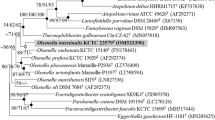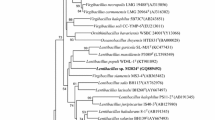Abstract
Two novel Gram-stain negative facultative anaerobic, motile, rod-shaped bacterial strains IG-V01T and IG-V01b were isolated from the gut of red flour beetles, Tribolium castaneum. The 16S rRNA gene sequences of strains IG-V01T and IG-V01b were found to have their highest sequence similarity (96.5 % and 96.4 %) with Serratia nematodiphila DZ0503SBS1T (Enterobacteriaceae family) respectively. Strains IG-V01T and IG-V01b share 100 % 16S rRNA gene sequence similarity and exhibit very similar phenotypic characteristics. In addition, they show 89.7 % genomic relatedness (DNA–DNA hybridisation). Major fatty acids were identified to be C16:0 (38.3 %), C17:0 cyclo (19.5–20 %) and C14:0 (11.2–11.3 %). Cells contain phosphatidylethanolamine and diphosphatidylglycerol as predominant polar lipids. Genomic DNA G+C content (mol%) was determined to be 51.5–51.7. A polyphasic approach employing the study of morphological, physiological, chemotaxonomic, genomic and phylogenetic analysis revealed that the two newly isolated strains cannot be placed in any of the existing genera of the family Enterobacteriaceae. Therefore, it is proposed that strains IG-V01T and IG-V01b belong to a novel genus within the family Enterobacteriaceae, and represent a new species Enterobacillus tribolii gen. nov., sp. nov., with the type strain =IG-V01T = KCTC 42159T = MCC 2532T.

Similar content being viewed by others
References
Bligh EG, Dyer WJ (1959) A rapid method of total lipid extraction and purification. Can J Biochem Physiol 37:911–917
Brady CL, Cleenwerck I, Venter SN, Vancanneyt M, Swings J, Coutinho TA (2008) Phylogeny and identification of Pantoea species associated with plants, humans and the natural environment based on multilocus sequence analysis (MLSA). Syst Appl Microbiol 31:447–460
Brady CL, Venter SN, Cleenwerck I, Vandemeulebroecke K, De Vos P, Coutinho TA (2010) Transfer of Pantoea citrea, Pantoea punctata and Pantoea terrea to the genus Tatumella emend. as Tatumella citrea comb. nov., Tatumella punctate comb. nov. and Tatumella terrea comb. nov. and description of Tatumella morbirosei sp. nov. Int J Syst Evol Microbiol 60:484–494
Brenner DJ, Farmer JJ (2005) Family I. Enterobacteriaceae. In: Brenner DJ, Krieg NR, Staley JT, Garrity GM (eds) Bergey’s Manual of Systematic Bacteriology, (The Proteobacteria), Part B (The Gammaproteobacteria), vol 2, 2nd edn. Springer, New York, pp 587–594
Card GL (1973) Metabolism of phosphatidylglycerol, phosphatidylethanolamine, and cardiolipin of Bacillus stearothermophilus. J Bacteriol 114:1125–1137
Dauga C (2002) Evolution of the gyrB gene and the molecular phylogeny of Enterobacteriaceae: a model molecule for molecular systematic studies. Int J Syst Evol Microbiol 52:531–547
DeLey J, Cattoir H, Reynaerts A (1970) The quantitative measurement of DNA hybridization from renaturation rates. Eur J Biochem 12:133–142
Dillon RJ, Dillon VM (2004) The gut bacteria of insects: nonpathogenic interactions. Annu Rev Entomol 49:71–92
Drancourt M, Bollet C, Carta A, Rousselier P (2001) Phylogenetic analyses of Klebsiella species delineate Klebsiella and Raoultella gen. nov., with description of Raoultella ornithinolytica comb. nov., Raoultella terrigena comb. nov. and Raoultella planticola comb. nov. Int J Syst Evol Microbiol 51:925–932
Gavini F, Mergaert J, Beji A, Mielcarek C, Izard D, Kersters K, De Ley J (1989) Transfer of Enterobacter agglomerans (Beijerinck 1888) Ewing and Fife 1972 to Pantoea gen. nov. as Pantoea agglornerans comb. nov. and Description of Pantoea dispersa sp. nov. Int J Syst Bacteriol 39:337–345
Gillis M, Ley JD, Cleene MD (1970) The determination of molecular weight of bacterial genome DNA from renaturation rates. Eur J Biochem 12:143–153
Gonzalez JM, Saiz-Jimenez C (2002) A fluorimetric method for the estimation of G+C mol% content in microorganisms by thermal denaturation temperature. Environ Microbiol 4:770–773
Gonzalez JM, Saiz-Jimenez C (2005) A simple fluorimetric method for the estimation of DNA–DNA relatedness between closely related microorganisms by thermal denaturation temperatures. Extremophiles 9:75–79
Grimont F, Grimont PAD (2006) The genus serratia. In: Dworkin M, Falkow S, Rosenberg E, Schleifer KH, Stackebrandt E (eds) Prokaryotes, 3rd edn. Springer, New York, pp 219–244
Gu CT, Li CY, Yang LJ, Huo GC (2014) Enterobacter xiangfangensis sp nov isolated from Chinese traditional sourdough and reclassification of Enterobacter sacchari Zhu et al 2013 as Kosakonia sacchari comb nov. Int J Syst Evol Microbiol 64:2650–2656
Harley JP, Prescott LM (2002) Laboratory exercises in microbiology. 5th edn. The McGrow Hill, New York, pp 13–014, 147–149
Hollis DG, Hickman FW, Fanning GR, Farmer III JJ, Weaver RE, Brenner DJ (1981) Tatumella ptyseos gen. nov., sp. nov., a member of the family Enterobacteriaceae found in clinical specimens. J Clin Microbiol 14:79–88
Holmes B, Farmer JJ III (2009) International committee on systematics of prokaryotes: subcommittee on the taxonomy of Enterobacteriaceae; minutes of the meetings, 7 August 2008, Istanbul, Turkey. Int J Syst Evol Microbiol 59:2643–2645
Hormaeche E, Edwards PR (1960) A proposed genus Enterobacter. Int Bull Bacteriol Nomencl Taxon 10:71–74
Iversen C, Mullane N, McCardell B, Tall BD, Lehner A, Fanning S, Stephan R, Joosten H (2008) Cronobacter gen. nov., a new genus to accommodate the biogroups of Enterobacter sakazakii, and proposal of Cronobacter sakazakii gen. nov., comb. nov., Cronobacter malonaticus sp. nov., Cronobacter turicensis sp. nov., Cronobacter muytjensii sp. nov., Cronobacter dublinensis sp. nov., Cronobacter genomospecies, and of three subspecies, Cronobacter dublinensis subsp. dublinensis subsp. nov., Cronobacter dublinensis subsp. lausannensis subsp. nov. and Cronobacter dublinensis subsp. lactaridi subsp. nov. Int J Syst Evol Microbiol 58:1442–1447
Kageyama B, Nakae M, Yagi S, Sonoyama T (1992) Pantoea punctata sp. nov., Pantoea citrea sp. nov., and Pantoea terrea sp. nov. isolated from fruit and soil samples. Int J Syst Bacteriol 42:203–210
Kämpfer P, Ruppel S, Remus R (2005) Enterobacter radicincitans sp. nov., a plant growth promoting species of the family Enterobacteriaceae. Syst Appl Microbiol 28:213–221
Kim OS, Cho YJ, Lee K, Yoon SH, Kim M, Na H, Park SC, Jeon YS, Lee JH, Yi H, Won S, Chun J (2012) Introducing EzTaxon-e: a prokaryotic 16S rRNA gene sequence database with phylotypes that represent uncultured species. Int J Syst Evol Microbiol 62:716–721
Kimura ZI, Chung KM, Itoh H, Hiraishi A, Okabe S (2014) Raoultella electrica sp. nov isolated from anodic biofilms of a glucose-fed microbial fuel cell. Int J Syst Evol Microbiol 64:1384–1388
Lane DJ (1991) 16S/23S rRNA sequencing. In: Stackebrandt E, Goodfellow M (eds) Nucleic acid techniques in bacterial systematics. Wiley, New York, pp 115–175
Loveland-Curtze J, Miteva VI, Brenchley JE (2011) Evaluation of a new fluorimetric DNA-DNA hybridization method. Can J Microbiol 57:250–255
Malka H, Svetlana F, Ismaeel NA, Ido I (2013) Rosenbergiella nectarea gen. nov., sp. nov., in the family Enterobacteriaceae, isolated from floral nectar. Int J Syst Evol Microbiol 63:4259–4265
Marmur J (1961) A procedure for isolation of deoxyribonucleic acid from micro-organisms. J Mol Biol 3:208–218
Mollet C, Drancourt M, Raoult D (1997) rpoB sequence analysis as a novel basis for bacterial identification. Mol Microbiol 26:1005–1011
Sambrook J, Fritsch EF, Maniatis T (1989) Molecular cloning: a laboratory manual, 2nd edn. Cold Spring, Harbor
Sasser M (1990) Identification of bacteria through fatty acid analysis. In: Klement Z, Rudolph K, Sands DC (eds) Methods in phytobacteriology. Akademiai Kiado, Budapest, pp 199–204
Steinhaus EA (1941) A study of the bacteria associated with thirty species of insects. J Bacteriol 42:757–790
Tamura K, Sakazaki R, Kosako Y, Yoshizaki E (1986) Leclercia adecarboxylata gen. nov., comb. nov., formerly known as Escherichia adecarboxylata. Curr Microbiol 13:179–184
Tamura K, Peterson D, Peterson N, Stecher G, Nei M, Kumar S (2011) MEGA5: molecular evolutionary genetics analysis using maximum likelihood, evolutionary distance, and maximum parsimony methods. Mol Biol Evol 10:2731–2739
Tindall BJ (1990) A comparative study of the lipid composition of Halobacterium saccharovorum from various sources. Syst Appl Microbiol 13:128–130
Vandamme P, Pot B, Gillis M, De Vos P, Kersters K, Swings J (1996) Polyphasic taxonomy, a consensus approach to bacterial systematics. Microbiol Rev 60:407–438
Wayne LG, Brenner DJ, Colwell RR, Grimont PAD, Kandler O, Krichevsky MI, Moore LH, Moore WEC, Murray RGE, Stackebrandt E, Starr MP, Trüper HG (1987) International committee on systematic bacteriology. Report of the ad hoc committee on reconciliation of approaches to bacterial systematics. Int J Syst Bacteriol 37:463–464
Werkman CH, Gillen GF (1932) Bacteria producing trimethylene glycol. J Bacteriol 23:167–182
Yarza P, Spröer C, Swiderski J, Mrotzek N, Spring S, Tindall BJ, Gronow S, Pukall R, Klenk HP (2013) Sequencing orphan species initiative (SOS): filling the gaps in the 16S rRNA gene sequence database for all species with validly published names. Syst Appl Microbiol 36:69–73
Zhang CX, Yang SY, Xu MX, Sun J, Liu H, Liu JR, Liu H, Kan F, Sun J, Lai R, Zhang KY (2009) Serratia nematodiphila sp. nov., associated symbiotically with the entomopathogenic nematode Heterorhabditidoides chongmingensis (Rhabditida: Rhabditidae). Int J Syst Evol Microbiol 59:1603–1608
Acknowledgments
This work was supported by the Department of Biotechnology (DBT), Government of India under the project ‘‘Establishment of Microbial Culture Collection’’ (Grant no. BT/PR/0054/NDB/52/94/2007). We acknowledge Dr. Neetha Joseph and Prachi Karodi for FAME analysis and assistance in biochemical tests respectively. Dr. Praveen Rahi is acknowledged for ribosomal protein profiling by MALDI-TOF (MS). Mr. Dhananjay P. Patil is acknowledged for his assistance during initial isolation. We thank Dr. Bernhand Schink for etymology of the novel genus and species. Dr. Tapan Chakrabarti is acknowledged for valuable suggestions in the discussion section and etymology.
Author information
Authors and Affiliations
Corresponding author
Additional information
Vikas S. Patil and Rahul C. Salunkhe have equally contributed to the manuscript.
The GenBank/EMBL/DDBJ accession numbers for the 16S rRNA, rpoB and gyrB gene sequences of strains IG-V01T and IG-V01b are HG972968, LM993265, LM993263 and LK934679, LM993266, LM993264 respectively.
Electronic supplementary material
Below is the link to the electronic supplementary material.
Rights and permissions
About this article
Cite this article
Patil, V.S., Salunkhe, R.C., Patil, R.H. et al. Enterobacillus tribolii gen. nov., sp. nov., a novel member of the family Enterobacteriaceae, isolated from the gut of a red flour beetle, Tribolium castaneum . Antonie van Leeuwenhoek 107, 1207–1216 (2015). https://doi.org/10.1007/s10482-015-0412-8
Received:
Accepted:
Published:
Issue Date:
DOI: https://doi.org/10.1007/s10482-015-0412-8




